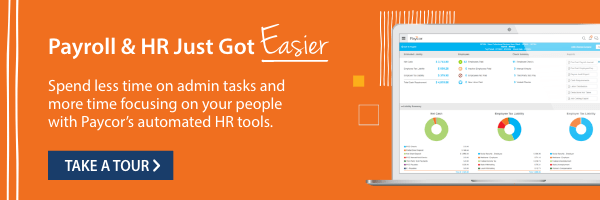Many organizations are feeling the pressure to do even more with less — fewer employees, fewer resources, and smaller budgets. As an HR leader, you might be wondering what you can do to confront the labor cost issue head-on and find solutions.
Labor costs can account for as much as 70% of total business costs according to the U.S. Bureau of Labor Statistics. Yet, according to a Paycor survey, HR professionals only spend 15% of their time managing the cost of labor. Failure to manage labor costs can cause a range of financial and operational issues for businesses, including reduced profit margins, increased turnover, and operational inefficiencies.
Keeping an eye on the annual operational costs empowers you to prepare for the financial future. To be an asset as an HR leader, you need to think like a financial executive, but also be creative with ways of reducing costs.
What Are Labor Costs?
First, let’s define labor costs. The cost of labor refers to all of the expenses a business incurs to maintain its workforce. This includes wages, benefits, and payroll taxes. Indirect costs also add to the total, like recruitment and training expenses. Labor costs generally account for a company’s largest operating expense.
How to Reduce Labor Costs
With inflation sweeping the nation, many economic signals point to a looming recession. J.P. Morgan lists the probability of a recession taking hold by the end of 2025 at 45%.
Companies are left wondering how to reduce annual costs of labor without gutting their workforce, slashing employee hours, or making other unpopular decisions.
While there is no one-size-fits-all answer to this question, there are a few strategies that can help you get started. Here are five tips for reducing labor expenses:
- Cut back on overtime: If your employees are working more than 40 hours a week, consider cutting their hours back to 40. This will save your organization money on labor while still allowing your employees to earn a decent wage. Learn how Baker Concrete Construction Society reduced overtime with Paycor in this case study.
- Offer incentives for employees to work their allotted hours: You could offer a bonus for employees who stay within their allotted hours. This will help to motivate your employees to work fewer hours, which will in turn cut costs.
- Carefully hire the right candidates from the beginning: The average cost of turnover is up to 30% of an employee’s first-year wages, so this is an important strategy for reducing annual costs of labor in the long run.
- Use temp labor during busy times:If you have peaks and valleys in your business, consider using temp labor during your busy times to help with the workload.
- Utilize labor forecasting: Labor forecasting uses historical data to ensure you have the right number of employees at precisely the right time.
Having access to labor information allows you to plan for the future and helps your organization make more informed decisions. Armed with the right data and advanced technologies, like Paycor’s Time & Attendance software, you can create a strategy to correct any problems and more easily predict when you might need additional staff in the future, which enables better budget forecasting.
Which Industries Have the Highest Labor Costs?
According to IBISWorld, the industries with the highest labor costs in the U.S. are:
- Public schools
- Hospitals
- IT consulting
- Colleges and universities
- Professional employer organizations
- Specialist doctors
- Software publishing
- Management consulting
- Medical group practice management
- Portfolio management and investment advice
Trends in Labor Costs
According to Bureau of Labor Statistics data analyzed by The Center for American Progress, American wages are at an all-time high, even outpacing inflation. However, the most recent Salary Budget Planning Report by WTW shows businesses tightening their purse strings. Nearly half (47%) of respondents report their salary budgets for the 2024 cycle are lower than the previous year. The overall median pay raise for 2024 fell to 4.1%, compared with 4.5% in 2023.
Still, WTW reports salary budget increases are expected to rise by 3.9% in 2025. That’s why it’s important to know how to strategically establish salary ranges.
Employer labor expenses also include benefits. Mercer data shows the total health benefit cost per employee is expected to rise 5.8% on average in 2025, even after accounting for planned cost-cutting measures. For small companies, the average increase is 9% before cost-reduction measures.
How Can HR and Finance Departments Work Better Together?
HR and finance teams can work better together if they take a walk in each other’s shoes. To start thinking like a CFO when approaching business expenses, ask yourself these questions:
Are We Overspending on Labor?
Check overtime. There may be hidden costs that you need to watch out for. Look for a human capital management tool that analyzes workforce data, showing you overtime costs and helping forecast future labor needs.
Consider implementing flexible work options to reduce overtime and boost employee satisfaction. Options like compressed schedules or remote work can also help attract and retain top talent in today’s competitive labor market.
Are We Underutilizing Our Workforce?
If HR isn’t tapping into the full spectrum of talent in your company, you’re leaving money on the table. By not taking full advantage of your employees’ potential, disengagement and lack of motivation soon follow. This leads to a dramatic decrease in productivity and high turnover rates, which negatively impacts your company’s bottom line.
Are We Accurately Capturing and Recording Time Worked?
HR can lead the way by championing a time management solution that accurately tracks and manages hourly workers, eliminates duplication errors, and reduces payroll losses.
Are We Looking At Labor Costs in Silos?
If you’re not adding non-employee (freelancers, contract workers, consultants) and contingent labor into the labor cost equation, your numbers will be way off. You run the risk of potentially misclassifying employees and non-employees, which can result in harsh fines if the company is audited.
Now that you are thinking like a CFO and working alongside them, it is important to understand labor expenses, what is normal, and how to optimize your company’s budget.
What is An Acceptable Labor Cost Percentage?
An acceptable average cost percentage is 25-35% of gross sales. This varies depending on the business, industry, and location. For example, a retail store in a small town may have labor percentages less than 25%, while the manufacturing sector may have labor percentages higher than 35%.
There are many factors that contribute to the total labor cost percentage for a business, including the type of business, the industry, the unit labor cost, location, and the number of employees.
The type of work and the wage rates can also affect the total labor cost percentage for employees.
What Percent of a Business’ Costs Are Labor?
The percentage varies, but labor costs include employee’s salaries, cost of benefits, and taxes. They are often broken up into direct costs and indirect costs.
The sales price of a product or service takes into account the labor costs and any other overhead expenses, including materials. When these prime costs are taken into consideration, then you are able to see if the cost of labor is too high or too low.
If a company has to lower its prices, then they are going to have to cut labor costs as well, so they are not running in the negative. Restaurant industry labor costs are lower, as many of the staff receives tips.
Direct Costs vs. Indirect Labor Costs
Direct costs are tied to the production of a product or service, such as a production line worker in the manufacturing sector or a salesperson. Indirect labor costs are not tied to production and could be classified as someone in security.
Fixed vs. Variable Costs
Salaries paid to your workforce are fixed annual costs, as they don’t change based on production.
Overtime, temporary staffing, commissions, and bonuses are all considered variable labor costs since they change depending on many different factors.
Variable cost is often hard to predict, but it’s an important component of determining your company’s annual labor cost. In the manufacturing sector, the costs are variable, as the output of machines can change.
Labor Cost Percentage Formula
Calculating labor costs is pretty straightforward. To find your labor cost percentage, divide your labor cost by gross sales and multiply by 100.
Labor Cost Percentage = (Total Labor Cost / Total Gross Sales) x 100
For example: If your labor costs total $250,000 and gross sales equal $500,000, the labor cost formula would look like this: 250,000 ÷ 500,000 x 100 = 50%.
Be sure to include the cost of all bonuses, commissions, benefits, and taxes.
How Paycor Helps
Having a good understanding of your current labor costs and trends proves essential for keeping spending in check. With workforce management solutions, companies can increase productivity and lower costs. Paycor offers the following solutions:
- Time and Attendance Software: Automated and accurate timekeeping enables you to manage time off, track hours worked, and stay on top of labor distribution.
- Scheduling Software: Automate and optimize scheduling with templates and drag-and-drop functionality that empowers users to maximize efficiency and increase productivity.
- HR Analytics Software: Analytics allow you to access real-time labor cost data and insights to identify trends and opportunities for improvement. In addition, you can analyze compensation data, benchmark against industry standards, and identify potential pay disparities.
Effective workforce management is essential for controlling labor costs, boosting productivity, and helping ensure compliance. Download Paycor’s free Workforce Management Toolkit to learn strategies and tools to transform your workforce management practices and achieve lasting success.










